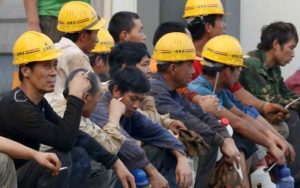Will China’s OBOR Hit A Silk Road Ceiling?
 China’s OBOR projects, thus far well illustrated by the Official OBOR Portal, have been exclusively driven by Chinese State Owned Enterprises. Many of these have diversified from their original purpose, such as the somewhat disconcerting sight of China Nuclear Energy Industrial Corp (CNEIC) proudly advertising the fact that they are the main contractors for building several skyscrapers in downtown Colombo, the capital of Sri Lanka. Locals wonder exactly what the buildings are being made of, in signs that China’s SOEs may not yet fully appreciate the wisdom behind alternative branding.
China’s OBOR projects, thus far well illustrated by the Official OBOR Portal, have been exclusively driven by Chinese State Owned Enterprises. Many of these have diversified from their original purpose, such as the somewhat disconcerting sight of China Nuclear Energy Industrial Corp (CNEIC) proudly advertising the fact that they are the main contractors for building several skyscrapers in downtown Colombo, the capital of Sri Lanka. Locals wonder exactly what the buildings are being made of, in signs that China’s SOEs may not yet fully appreciate the wisdom behind alternative branding.
In terms of Chinese SOEs operating in just Sri Lanka alone, the number reaches beyond the ten digits on my hands in what remains a relatively small island nation. This demonstrates that the link between the Chinese Government and Chinese state owned businesses has never been stronger. Despite decades of foreign investment and influence in China, the CCP steadfastly refuses to give up its hold on major businesses. This itself is part of the on-going game of Chinese Political Poker; Chinese political individuals and families maintain political power and influence via holding onto, and jealously guarding assets they are in control of. Such companies may be classified as SOEs, but make no mistake, many of these companies are run and directed as miniature fiefdoms. As long as they manage to pull together in generally the same direction as the Politburo, everything is hunky dory.
This also explains, to some degree, why China needs the OBOR initiative. Although the main driver is the sustaining of the CCP via securing essential supplies of energy, agriculture, and inexpensive consumer products, a domestic slowdown after 20 years of double digit growth has lead many SOEs to branch out overseas in search of dollar value. Often, Chinese migrant workers go along for the ride, encased in temporary, yet secure mini cities in foreign countries to work day in, day out, on building infrastructure in poorer nations. Few Kenyan workers were employed in building the Mombassa-Nariobi rail link, which recently opened. Limited numbers of Sri Lankans were employed in the building of the nations’ Southern Expressway. The loans given by China to build infrastructure overseas includes money for the employment of Chinese, and not local workers. Such financing is a massive merry go round of the RMB – loaned to foreign nations, then making its way back to China in the form of supplies and wages. Thus far, this has been how OBOR operates, a cozy relationship between the Chinese Government and its SOEs, fulfilling basic infrastructure work in foreign countries.
To be fair to China, other Empires and Nations have had similar opportunities, yet they have either shied away from the expense, exhibited a lack of organizational capability, or did not possess the basic resource that China has – labor – and plenty of it. The demise of the British Empire in Africa and India was arguably due to the lack of British nationals available to sustain it. For China, such problems do not exist.
So far, so good. However, what OBOR under the existing circumstances really means is that it has limits. To date, none of the projects undertaken have been especially groundbreaking in terms of technical difficulty. Roads, rail, ports, energy; all these are essentially large construction projects built by cheap Chinese labor, with well proven Chinese management techniques. That is often very handy for countries such as Sri Lanka, where annoying labor laws and rights, in a noisy democracy, could cause severe headaches for any incumbent local government. Getting the Chinese to quietly work away under disciplined conditions no Sri Lankan would tolerate is a key component of China success in exporting and marketing OBOR.
But what lies beyond? Will China, having turned many of its SOEs into huge overseas construction businesses, hit a glass ceiling? The implications are serious. Already, warning signs for China are there that Chinese SOEs may not be capable of developing business models much beyond basic construction and cheap labour, funded by the State Owned Banks. Examples are in Russia, where the much lauded Moscow-Kazan High Speed Rail is expected to be operational by 2019. Beijing would like to see that route eventually extended all the way through to Beijing, but the real technical part – the actual locomotives – are not being sourced from China. Although China’s CRRC, the builder of rolling stock are involved, it is in an enterprise formed by Russia’s Sinara Group and Siemens who are already working on the freight train project. They will launch the production of trains at the Ural Locomotives manufacturing plant. One more production site will be chosen in Central Russia, with all locomotives to be built in Russia. In short, Chinese labor will do the grunt work in clearing ground for high speed tracks. But the real technical capabilities will be sourced from Russia and Germany.
There is, it seems, a Silk Road Ceiling that Chinese SOEs are already hitting. Getting beyond this will take a huge shift in Chinese political dynamics. I have previously explained how OBOR projects in Indonesia were financed by China but with the express caveat that financing was to be spent on Indonesian SOEs only and was not to filter down into Indonesia’s private sector. Such financing constraints can cover up a variety of sins, from corruption to avoiding WTO anti-competition regulations. China can continue to do this while funding its own SOEs in overseas projects; however, there are limitations to this when it comes to higher levels of technology. Beijing needs to be very careful it doesn’t inadvertently stymie the entire economy by promoting the use of its SOEs as de facto construction only Build-Operate-Transfer businesses. If they do, innovation will suffer, and the country could find itself eventually backward in terms of what it can actually do once all the basic OBOR infrastructure is built. On-going maintenance of the Nairobi-Mombassa railway tracks won’t be carried out by the Chinese – Kenyans will benefit from the technology transfer and work out how to do it themselves.
The answer for China to avoid the Silk Road Ceiling is to instigate Public-Private Partnerships (PPP) in which a combination of Government and Private Enterprise works together to develop a project.
Infrastructure investment in Asia alone, from 2016 through to 2030 is estimated to cost about US$26 trillion, with the private sector expected to foot a large part of the bill. In 24 countries and regions and through to 2020 alone, this sector will be asked to invest US$250 billion per year. However, there are shortfall problems, as private investment in infrastructure development in Asia is currently about US$63 billion per year. In China, it is hard to separate the Government from its SOEs – Beijing can argue that it is already well advanced with PPP projects. But that’s not the same as having true private enterprises involved, which tend to be the companies with the latest and newest technologies and innovations. After all, China’s CNEIC didn’t have far to look when deciding to diversify from building nuclear power plants to building office blocks. It wasn’t an innovative direction to take in what ought to be a primary business for innovation.
In order to attract the private sector, PPP’s with promise of concessions, are used to attract private sector companies to not only invest money, but also to transfer technology and operational know-how in infrastructure development with the aim of earning a worthwhile return.
To find willing investors, countries must have a framework in place that ensures transparency, fairness, and predictability, such as reliable policy and regulation as well as specialized PPP branches of government that investors can trust. India, for example, has made real strides with this as New Delhi strives to shake off decades of Governmental incompetence. The entire national redevelopment of India’s ports has been placed under PPP schemes.
China’s problem is that it doesn’t have this mechanism in place. The OBOR initiative contains no framework to allow foreign participation, and in practice, even discourages private enterprise participation by discouraging funding or involvement with it.
In fact, the entire OBOR initiative doesn’t appear to possess a detailed strategic execution plan. There are no clear definitions, projections of investment costs, or return on investment data. China has instead just broadly announced “it is ready to invest” into the OBOR, while at the same time giving no detail on any expected returns in respect of financial involvement or what the national economies of the participating countries should do to become involved. The ambiguity of the OBOR initiative in effect guarantees its success as no one is able to assess it. This additionally gives China the right to change the rules of the game depending on the situation, in what remains a complicated part of the world.
However, Beijing may live to regret its stance. OBOR remains an amazing project and the infrastructure it builds are both much needed and will benefit the global economy in many ways. But in committing China’s SOEs so deeply to it, and expressly avoiding relationships with the international private sector, Beijing is in danger of doing great harm to China’s industrial base and committing it for decades into a technically backwards orgy of build, build, build. Without the private sector involved, China’s OBOR scheme could commit the nations’ industries to a life underneath the Silk Road Ceiling. OBOR needs to have a mechanism to open up space for technical innovations, lest China’s technical ambitions are not to disappear into a dense cloud of cement and poured concrete.
Related Reading:
Silk Road and OBOR Business Intelligence
Dezan Shira & Associates´ Silk Road and OBOR investment brochure offers an introduction to the region and an overview of the services provided by the firm. It is Dezan Shira´s mission to guide investors through the Silk Road´s complex regulatory environment and assist with all aspects of establishing, maintaining and growing business operations in the region.
China’s New Economic Silk Road
This unique and currently only available study into the proposed Silk Road Economic Belt examines the institutional, financial and infrastructure projects that are currently underway and in the planning stage across the entire region. Covering over 60 countries, this book explores the regional reforms, potential problems, opportunities and longer term impact that the Silk Road will have upon Asia, Africa, the Middle East, Europe and the United States.
Investing in India’s Public Private Partnerships
In this issue of India Briefing, we examine India’s public-private partnerships. The Indian economy demands massive investment in infrastructure to sustain the country’s growth. To accomplish this, the government has announced a series of measures to encourage private investment in India’s public sectors.









